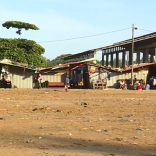FACIM 2025: Mozambican firms sign over 800 business and investment agreements
Barclays Mozambique: A rare gem in a shattered industry

Barclays Mozambique (File photo)
2016 is certainly a year to forget for the African banking industry, as many banks are being rescued by their respective regulatory authorities. It is less true for Barclays Mozambique, whose superior performances in 2016 strongly contrast with that of other competitors across the continent and in Mozambique.
Indeed, the bank published yesterday an increase of more than 85% of its after-tax profits at MZM 575 million (USD 8.45 million) for the fiscal year 2016. (Before-tax profits even increased 140% to more than MZM 739 million). It is the second consecutive annual growth of the bank’s net results. This enabled Barclays Mozambique to display a return on equity (RoE) of 13.8% versus a little more than 8% last year.
More importantly, the bank was able to generate such performances while tightening credit conditions in a context of economical strain in Mozambique. A patent sign that the bank’s strategic approach continues to bear fruit. The strategy consists indeed on a greater focus on high-quality, premium clients, namely corporate customers on one hand and, on the other hand, on maintaining a disciplined loan book.
On the first aspect, the bank was able to attract 5% more clients (at a little more than 283.000) than last year, most of which came from the institutional segment. This strongly contributed in doubling the ratio of profit to total deposits. While Barclays Mozambique’s CEO, Rui Barros, insists that retail clients remain a central focus for the bank’s long term goals, the economic situation in Mozambique prompted the group to be particularly cautious in regards to this segment in terms of credit growth.
“Among individual customers, we have noticed that a substantial number have either lost their employment, while others have seen a decline of their personal revenues”, comments Rui Barros, during a press conference held earlier in Maputo. This factor explains why the loan book has increased only moderately within that particular segment, preserving the bank from accumulating toxic assets as is the case with most highly pro-cyclical banks in Africa.
As a result of such cautiousness, Barclays Mozambique’s solvency ratio now stands at 22.5%. More than the double of the regulatory capital requirements (8%) and largely higher than the industry average. This figure has even slightly improved compared to 2015, when the ratio stood at 20%. Another key metric of the credit institution’s financial strength lies in its liquidity ratio, as expressed by its credit-to-deposit ratio of 73%, an increase of two percentage points compared to 2015.
Further confirming the bank’s philosophy of maintaining a strong financial position in order to ensure a sustainable growth profile, Barclays Mozambique decided not to distribute dividends to its shareholders this year. Instead of luring potentially short-term-minded investors, the institution will use its free capital to invest, ensuring a stable and gradual growth of its market share in the long term.
Faced with prolonged macro uncertainty about the Mozambican economy, the financial institution will also significantly increase provisions against bad loans. Rui Barros suspects that some defaults on the part of the bank’s clients (especially the retail ones), which occurred during the last quarter of 2016, may actually reflect, with some time lag, in the current fiscal year.
Indeed, the good results recorded in 2016 did not come without major challenges. High public debt has fueled a severe liquidity crisis in Mozambique, which prompted analysts to forecast historically low rates of GDP growth this year. “In the short term, we do not see signs of significant macro improvement in Mozambique, the end of the first quarter being the continuation of what has been observed during the last three months of 2016”, says Rui Barros. “However, we are convinced that the long term prospects of the country remain highly attractive compared to other countries in the sub-Saharan continent.”
All in all, Barclays Mozambique seems to have adopted a contrarian strategy compared with most credit institutions in Africa. Many African-based banks suffered a series of solvency issues, these being mainly the result of their aggressive loan growth strategy. In October last year, for instance, Ugandan-based Crane Bank’s board of directors was suspended by the regulator, after it was found undercapitalized while trying to prevent a bank run.
A couple of months earlier, Nigerian authorities also had to replace the management of its eighth largest credit institution. On their part, Kenya and Zambia both seized some of their smaller banks, while Mozambique also had to intervene to save Moza Banco from a run on deposit in September last year. Just as did the Government of the DRC, who had to step in to prevent one of its main lenders from filing for bankruptcy.
All those banks surfed on the above-than-normal growth theme of their respective economies before being put at risk by the collapse of commodity prices and global economic slowdown. China, Africa’s largest trade partner, whose economy is turning more into a domestic-oriented model, also explains the economic slowdown in Africa.
Cited by Bloomberg in September last year, Johannesburg-based consultancy firm Exx Africa had been “forecasting an African banking crisis” since the beginning of 2016. “We’re likely to see more banks fail in Nigeria. The Kenyan banking sector will have to consolidate and Ethiopia’s will have to liberalize. Angola is also struggling. Some Ghanaian banks have reported heavy losses. The other one to watch is the DRC, which has also seen some turbulence”, had detailed Exx Africa.
“Any crisis brings with it a higher probability of consolidation”, remarks Rui Barros. “However, the organic component of our growth strategy remains predominant, while potential targets for acquisition is always under watch”, added the CEO without further detailed, after Club of Mozambique asked if the bank had plans to acquire or invest in the capital of Moza Banco.
As a reminder, Moza Banco is now up for sale after its shareholders failed to recapitalize the bank. This, founded eight years ago, had managed to exceed Barclays Mozambique’s market share (around 5%) in the country at some point, mainly through an aggressive retail credit strategy.
However, the disciplined approach adopted by Barclays Mozambique ironically turned the latter among the few potential investors which could revitalize Moza Banco. Nevertheless, Rui Barros did not give concrete details about such acquisition possibility.
The banking crisis in Africa reveals how important it is for the industry to focus much more on risk management. Sustainability of their activities will strongly depend on a counter-cyclical growth strategy in a continent which still presents high financial and economic vulnerabilities due, in part, to their high dependency on exports of raw materials.
Barclays Mozambique, who had to face an excessive inflation (almost 20% in late 2016 vs less than 4% in 2015), will also continue to work on cost reductions while adding products to its portfolio of corporate clients. For instance, it has further invested in innovation, launching various initiatives related to credit cards management and online trading among others.
By Levy Sergio Mutemba













Leave a Reply
Be the First to Comment!
You must be logged in to post a comment.
You must be logged in to post a comment.